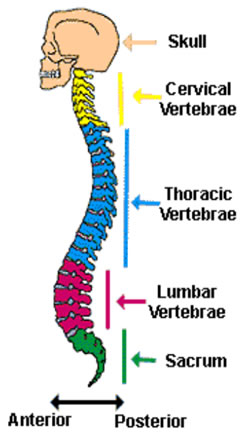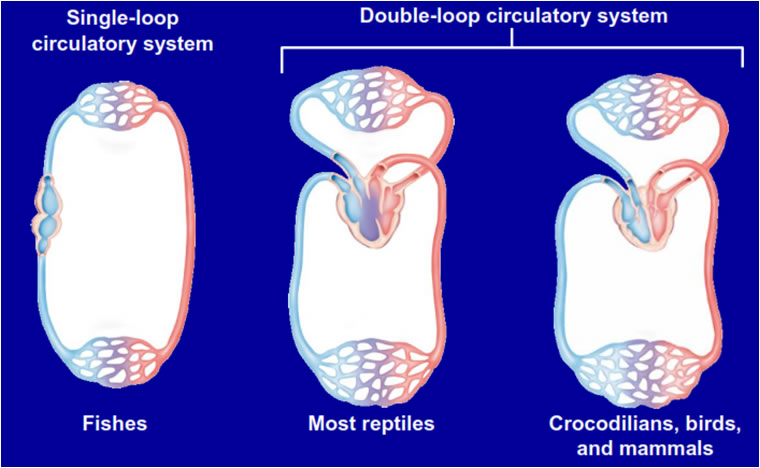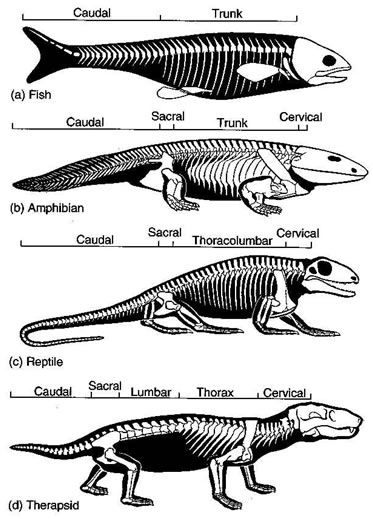DIVERSITY OF CHORDATES
| HOME | SUBPHYLUM VERTEBRATA |
The subphylum Vertebrata comprises of the most successful animals on earth. They colonize all ecosystems, terrestrial, aquatic and arboreal. This success could be attributed to a host of factors ranging from the efficient control and coordinating system, efficient blood circulatory system, strong skeletal system and the ability to regulate internal body temperature. Common vertebrates are fishes, frogs, lizards, birds and man
Some of the basic characteristics of Vertebrates are: The first three groups are commonly called fishes, while the remaining four groups are called tetrapods (they posses four limbs, called tetraapod limbs).
Vertebrates possess a vertebral column. The vertebral column helps in the support of the vertebrtae, given shape, sites for attachment of muscles aswell housing the spinal cord.
Vertebrates are cephalized. They have well demarcated head(a distinct head, with skull enclosing a brain) and body regions.
Figure 1 Vertebral column
Vertebrates have efficient respiratory system, which ensures efficient metabolic rate.The respiratory system range from bucoo-pharyngeal, cutaneous in amphibians to the pulmonary system in man.
Figure 2 Respiratory system of vertebrates
Vertebrates have well developed, complex control and coordinating system- The nervous system( complex brain and spinal cord), Sensory system, endocrine system and muscular system.
Figure 3 Nervous system of Vertebrates
Vertebrates have efficient closed, double blood circulatory system, and the lymphatic system. The blood circulatory system comprised of the four chambered heart, blood, and blood vessels. Its main functions is the transportation of blood, food, nutrients and defense. While the lymphatic system, comprised of the lymphatic vessels , the lymph and the lymph nodes. The main functions of the lymphatic system is the transportation of lymph and defense of the body.
Figure 4 Vertebrate blood circulatory system
The locomotary organs of vertebrates range from fins, wings to limbs in man. Vertebrates have strong endoskeleton, comprising of strong pectoral and pelvic girdles. The pectoral and pelvic girdles lifts the body, provide support and aids in movement. Vertebrates possess tetrapod( four) limbs that aids in efficient support, movement on land or flight.
Figure 5 Evoloution of vertebrate locomotory organs
Vertebrates can be able to regulate their internal body environment within specific limits. A process known as Homeostasis. For examples vertebrates can be able to regulate their body temperature, salt concentration, water concentration etc within their bodies
First vertebrates were marine, lacking jaws or paired fins. Later on the jawless fishes were replaced by jawed creatures. Amphibian ancestors were the first to invade the land. The Amphibians were later on replaced by the first group of reptiles called Dinosaurs. Dinosaurs and other reptiles ruled the earth for 150 million years. The Dinosaurs become extinct some million years ago and were replaced by the Aves and the mammals.
The vertebrates are composed of eight classes. Four classes are aquatic fishes. These are: 4.5.1.Class Pisces4.5.2.Class Amphibia - Salamanders, frogs and toads 4.5.3.Class Reptilia - Reptiles. 4.5.4.Class Aves - Birds. 4.5.5.Class Mammalia - Mammals
You have learnt the following from this module: 1.The vertebrates are group of animals that possess an elongated supporting structure called the Vertebral column.
2.The body of vertebrates may be covered by mucus, feathers or hairs
3.The vertebrates colonized all types of ecosystems
4.The vertebrates possess closed, double circulation system
5.The vertebrates have strong respiratory system
6.The Subphylum vertebrata are classified into five classes namely, Pisces, Amphibia, Reptilia, Aves and Mammalia
|
| Cephalochordata | Pisces |
2019 Digital Vision Digital Resources




